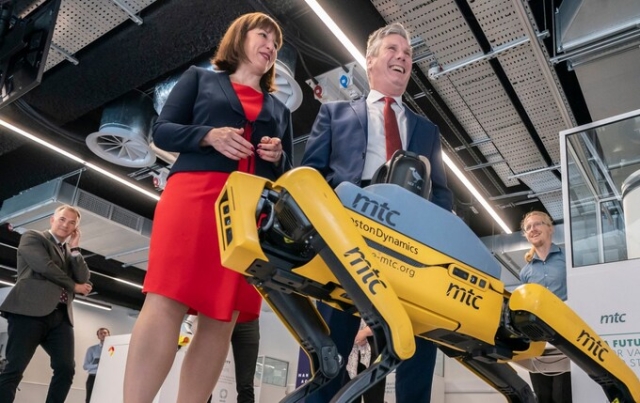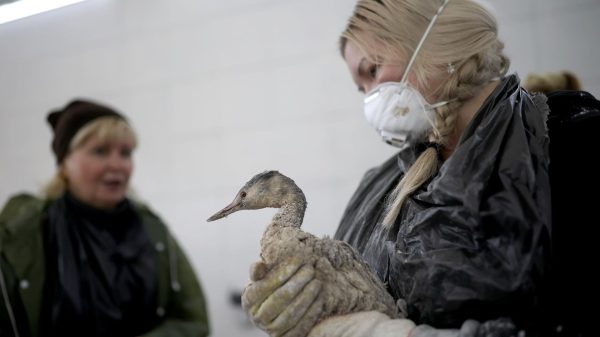 Sir Keir Starmer and Rachel Reeves watch the robot in action during a visit to the Manufacturing Technology Center. Photo: Danny Lawson/PA
Sir Keir Starmer and Rachel Reeves watch the robot in action during a visit to the Manufacturing Technology Center. Photo: Danny Lawson/PA
ASD Lighting's 200 employees have been making luminaires for airports, hospitals and offices at the company's Rotherham plant for 40 years, but in 2018 a couple of new hands appeared.
Robbie and Roberta, two robotic arms. , joined the production line by fixing the screws and installing the panels on the street lights. ASD says the robots are able to handle the most repetitive tasks, increasing productivity without changing staff and reducing the risk of injury such as RSI.
Universal Robots, the Dutch company that makes the weapons, says they cost around £33,000. “If you look at it, as opposed to hiring a person to complete a task, you will see that you will get payback quite quickly, maybe within a year,” says Mark Grey, UK and Ireland manager for the company.< /p>
The ASD Lighting example is relatively rare. The UK is lagging behind when it comes to bringing robots into the workplace.
0407 UK, Eurozone, China PMI
There were about 24,445 industrial robots in the UK in 2021, or 111 for every 10,000 manufacturing workers, according to the International Federation of Robotics (IFR). This has nearly doubled in a decade, but lags far behind international peers. The UK is ranked 24th in the world, the lowest in the G7 and below the global average of 141.
For comparison, the US has 274 robots per 10,000 workers, Germany has 397, and South Korea – 1000.
р><р>Last year's IFR annual report noted that «the UK has a strong manufacturing industry with a surprisingly low annual number of robots installed» with numbers that are «very low for a Western European country.»
Body noted that even in industries with more robots such as the automotive industry, the UK lags behind with 824 robots per 10,000 employees compared to Germany's 1,500.
The UK is also gradually lagging behind. Globally, annual installations of industrial robots more than tripled between 2011 and 2021. In the UK, they grew by only 36%. Installs have actually dropped from the two biggest years, 2012 and 2013.
The shortage is seen as part of the explanation for the low productivity levels in the UK and its industrial struggles. Figures last week showed the manufacturing sector shrinking at its fastest rate in more than three years. According to the Office for National Statistics, the UK was the only country that experienced a drop in productivity last year.
“We are one of the least productive countries in the G7,” Gray says. «If you look at the three countries with the highest productivity, that is, South Korea, Japan and Germany, these three countries are the most populous robots in the world.»
Robots are defined. as programmable machines, usually with joints and some kind of hand, compared to simple industrial equipment. They can generally be repurposed for a variety of tasks, making them more of an alternative to human labor than other equipment, and are used for tasks such as welding, laser cutting, and painting.
Half of today's stocks come from the automotive business, followed by chemicals, metals and food and beverages.
Peter Williamson, chief executive of the PPMA engineering association, says Britain has historically been more resilient. robots than in other countries. They first began to appear in the 1970s and 1980s, when labor disputes were at their height.
“There is a real perception in the UK that robots are taking over jobs. And, you know, this is something that has prevailed since the seventies, when many car manufacturers in the UK did not implement robotics because they did not want to upset or demotivate their workforce. The whole robotic industrial revolution that happened in the 70s and 80s in other parts of the world didn’t happen here.” predilection for cheap labor. “We kept thinking that cheap labor was the way forward, not automation,” says Williamson. «So it's a hangover.»
Governments have repeatedly pointed to the low level of robotics in the UK as a problem. In 2013, Coalition Science Minister David Willetts named it one of the «eight great technologies» that he hoped would fuel growth in the next decade.
1503 Employment share in selected sectors
Earlier this year, Lord Willetts , now a life peer, once again turned to technology and acknowledged that demographic factors were holding back investment. Bringing back labor-intensive manual car washes with automated alternatives is one example that goes beyond manufacturing.
Robots were highlighted in the government's 2017 industrial strategy, and a taxpayer-commissioned report in 2021 says their introduction could add pounds. $6.4 billion to output.
But it is the labor shock caused by Brexit that is likely to boost investment. Rishi Sunak has called for increased investment in robotics in areas such as the National Health Service and social assistance to address long-term workforce challenges.
The IFR says that “Robotic automation can make up for the growing shortage of low-wage workers. allowing the country to remain competitive.”
Grey of Universal Robotics says, “In the two years since Brexit, we've seen the biggest upswing in our business. We have an aging workforce—the average age of a welder is now 55. They have 10 years before retirement. And we can't replace that skill with young people fast enough. So we are seeing this turn. People are more open to robotics and automation.”



































































Свежие комментарии